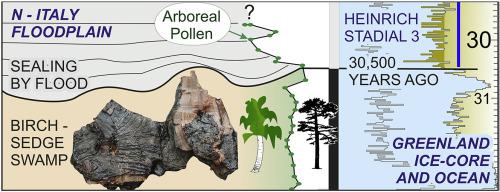当前位置:
X-MOL 学术
›
Rev. Palaeobot. Palynol.
›
论文详情
Our official English website, www.x-mol.net, welcomes your
feedback! (Note: you will need to create a separate account there.)
Birch-sedge communities, forest withdrawal and flooding at the beginning of Heinrich Stadial 3 at the southern Alpine foreland
Review of Palaeobotany and Palynology ( IF 1.7 ) Pub Date : 2020-09-01 , DOI: 10.1016/j.revpalbo.2020.104276 Cesare Ravazzi , Federica Badino , Renata Perego , Paolo Bertuletti , Mattia De Amicis , Massimiliano Deaddis , Lorena Garozzo , Massimo Domenico Novellino , Roberta Pini
Review of Palaeobotany and Palynology ( IF 1.7 ) Pub Date : 2020-09-01 , DOI: 10.1016/j.revpalbo.2020.104276 Cesare Ravazzi , Federica Badino , Renata Perego , Paolo Bertuletti , Mattia De Amicis , Massimiliano Deaddis , Lorena Garozzo , Massimo Domenico Novellino , Roberta Pini

|
Abstract The southern Alpine foreland, facing windward to moist southern airmasses, is claimed to have supported forest vegetation throughout the Last Glaciation. Here we present a multiproxy paleoecological record from a compressed peat, uncovered at Casaletto Ceredano, N-Italy, spanning the interval from 33 to 30.5 kyr cal BP. Stratigraphically, it underlies a fluvioglacial belt attributed to the Last Glacial Maximum. The peat records a floodplain swamp community with tree birch and tall sedges, pine woodlands in upland areas, and only limited patches of open vegetation. Plant macrofossils – bark, charcoal, wood and fruits – establish the predominant role of Betula pubescens group (downy birch) in the anoxic wetland, thanks to its ability to enhance gas exchange through a distinctive type of bark lenticels. A fire-induced birch-to-pine cycle is repeated twice along the 2500 years-time span covered by the peat layer. The climate reconstructed from modern pollen analogs compares to northern boreal zone, with Tjuly A major flood sealing the swamp with minerogenic silt is precisely dated to 30,497 ± 594 yr cal BP (2σ uncertainty). Here, the pollen record shows a substantial forest withdrawal, and development of grasslands and semideserts, pointing to co-factorial action of increased climate continentality and of river dynamics. According to teleconnections with the Atlantic and Arctic framework of the stadial–interstadial climate variability, the age and pattern of this event are consistent with the onset of Heinrich Stadial 3, causing a lockdown of moist westerlies and of their Rossby waves in the W-Mediterranean.
中文翻译:

阿尔卑斯山南部前陆 Heinrich Stadial 3 开始时的桦树莎草群落、森林撤退和洪水
摘要 南部阿尔卑斯前陆面向潮湿的南部气团迎风,据称在整个末次冰期都支持森林植被。在这里,我们展示了来自压缩泥炭的多代理古生态记录,在意大利北部的 Casaletto Ceredano 发现,跨越 33 到 30.5 kyr cal BP 的区间。在地层学上,它位于归因于末次盛冰期的河冰带之下。泥炭记录了漫滩沼泽群落,有桦树和高大的莎草,高地地区有松树林,只有有限的开阔植被。植物大体化石——树皮、木炭、木材和水果——在缺氧湿地中确立了 Betula pubescens group(绒毛桦)的主要作用,这要归功于其通过独特类型的树皮皮孔增强气体交换的能力。沿着泥炭层覆盖的 2500 年时间跨度,火灾引起的桦树到松树循环重复两次。从现代花粉类似物重建的气候与北方北方地区相比,Tjuly A 大洪水用矿质淤泥封闭了沼泽,其精确日期为 30,497 ± 594 yr cal BP(2σ 不确定性)。在这里,花粉记录显示了大量的森林撤退以及草原和半沙漠的发展,表明气候大陆性增加和河流动态的共同因素作用。根据与大西洋和北极圈间气候变化框架的遥相关,该事件的年龄和模式与 Heinrich Stadial 3 的开始一致,导致潮湿的西风及其在西地中海的罗斯比波被封锁.
更新日期:2020-09-01
中文翻译:

阿尔卑斯山南部前陆 Heinrich Stadial 3 开始时的桦树莎草群落、森林撤退和洪水
摘要 南部阿尔卑斯前陆面向潮湿的南部气团迎风,据称在整个末次冰期都支持森林植被。在这里,我们展示了来自压缩泥炭的多代理古生态记录,在意大利北部的 Casaletto Ceredano 发现,跨越 33 到 30.5 kyr cal BP 的区间。在地层学上,它位于归因于末次盛冰期的河冰带之下。泥炭记录了漫滩沼泽群落,有桦树和高大的莎草,高地地区有松树林,只有有限的开阔植被。植物大体化石——树皮、木炭、木材和水果——在缺氧湿地中确立了 Betula pubescens group(绒毛桦)的主要作用,这要归功于其通过独特类型的树皮皮孔增强气体交换的能力。沿着泥炭层覆盖的 2500 年时间跨度,火灾引起的桦树到松树循环重复两次。从现代花粉类似物重建的气候与北方北方地区相比,Tjuly A 大洪水用矿质淤泥封闭了沼泽,其精确日期为 30,497 ± 594 yr cal BP(2σ 不确定性)。在这里,花粉记录显示了大量的森林撤退以及草原和半沙漠的发展,表明气候大陆性增加和河流动态的共同因素作用。根据与大西洋和北极圈间气候变化框架的遥相关,该事件的年龄和模式与 Heinrich Stadial 3 的开始一致,导致潮湿的西风及其在西地中海的罗斯比波被封锁.











































 京公网安备 11010802027423号
京公网安备 11010802027423号